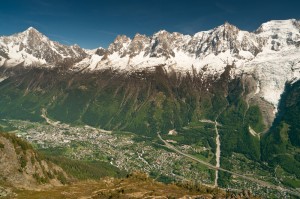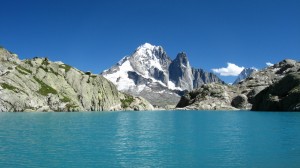 Located in the northwestern section of the Alps, Chamonix is only 15 km from both Italy and the Swiss border. Chamonix and its surrounding valley include the Mont Blanc chain in the south and the Aiguilles Rouges, or red peaks, in the north. The glacier-made valley measures 17 km and extends from the Col des Montets in the north to the Taconnaz torrent. The altitude at the town’s center is 1035 meters, and Le Tour is the highest village at the upper portion of the valley at an altitude of 1462 meters. The Arve River flows through the Chamonix valley to Geneva, where it meets the Rhone.
Located in the northwestern section of the Alps, Chamonix is only 15 km from both Italy and the Swiss border. Chamonix and its surrounding valley include the Mont Blanc chain in the south and the Aiguilles Rouges, or red peaks, in the north. The glacier-made valley measures 17 km and extends from the Col des Montets in the north to the Taconnaz torrent. The altitude at the town’s center is 1035 meters, and Le Tour is the highest village at the upper portion of the valley at an altitude of 1462 meters. The Arve River flows through the Chamonix valley to Geneva, where it meets the Rhone.
Chamonix is home to about 10,000 people. During the summer tourist season, Chamonix sees about 100,000 visitors each day, and during the winter season, it hosts about 60,000.
The spectacular viewpoints of Chamonix may be accessed either by hiking trails or by the lifts. Visitors can place themselves in the center of the panoramic views by traveling just a few minutes by cable or a few hours on foot.
Among the most famous ski resorts in the French Alps, Chamonix has extremely cold winters due to its high altitude, so it receives ample snow. The ski season runs from November to April. The most snowy months are February and March. The summers here are warm but wet at times. The climate of Chamonix is often quite humid. The region has its own microclimate and on any given day can experience a variety of weather. Sunshine can quickly turn to thunderstorms.
Glaciers in the valley cover 125 square km. Large forests separate the glaciers, crowned by rocks of granite at great heights, sculptured in obelisks and sprinkled with ice and snow. The Bossons and Mont-Blanc glacier, because of its steep incline, moves the fastest of all glaciers and reacts most quickly to changes in climate. The first ice grotto was excavated on its flanks in 1870. An outdoor exhibition, free of charge, relays the history of the glacier: the small ice age, its life, and its evolution.
 Three nature reserves encompassing 4000 hectares of territory in the mountains exhibit nature in undisturbed form: cliffs, vestiges of glaciers, lakes, and strange rock formations. A living laboratory with guides lets visitors explore the flora and fauna of the area.
Three nature reserves encompassing 4000 hectares of territory in the mountains exhibit nature in undisturbed form: cliffs, vestiges of glaciers, lakes, and strange rock formations. A living laboratory with guides lets visitors explore the flora and fauna of the area.
A for hotels in Chamonix, the town saw its first inn open in 1770. The first luxury hotel opened in 1816, and the industry thrived into the 1800′s. Three palaces were built in the 1900′s. Today Travelers will find many different types of accommodation in Chamonixavailable.
The introduction of rail and road access influenced Chamonix’s growth exponentially. 1901 saw the inauguration of the railway line from St. Gervais Le Fayet and Chamonix. This train improved access greatly and led the way winter sports tourism. Chamonix hosted the first Winter Olympic games in 1924, and the construction of many lifts followed.
Chamonix has become more than just a tourist destination; it is a link with Italy by the Mont-Blanc tunnel. This town juggles the demands of tourism, transport, and preservation of its magnificent natural environment. For more information on Chamonix, check out My Destination Chamonix.












